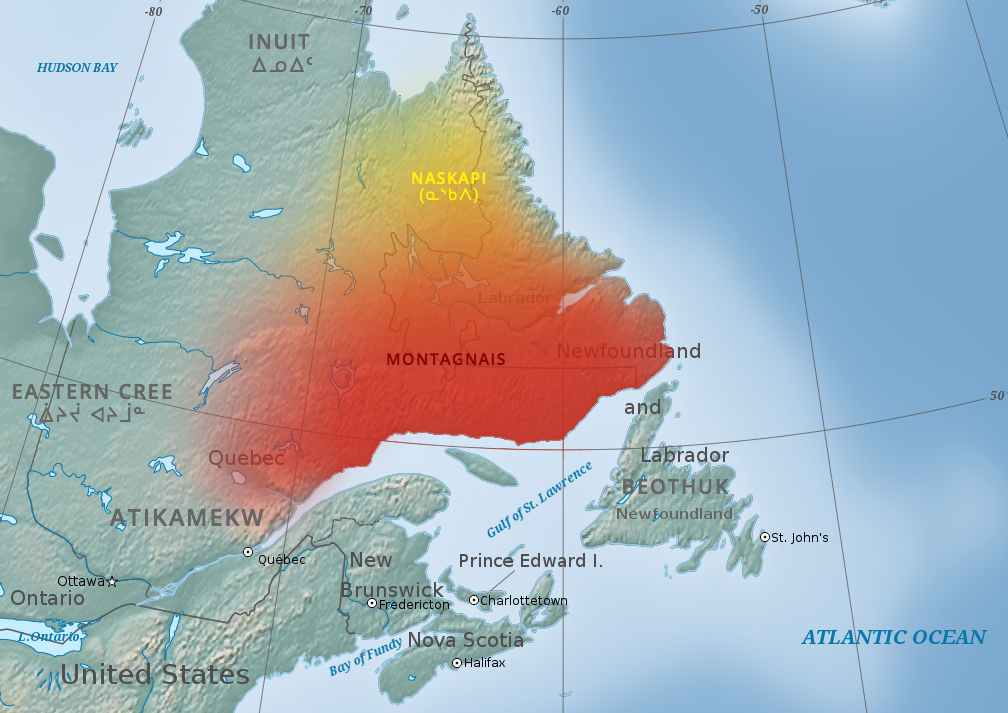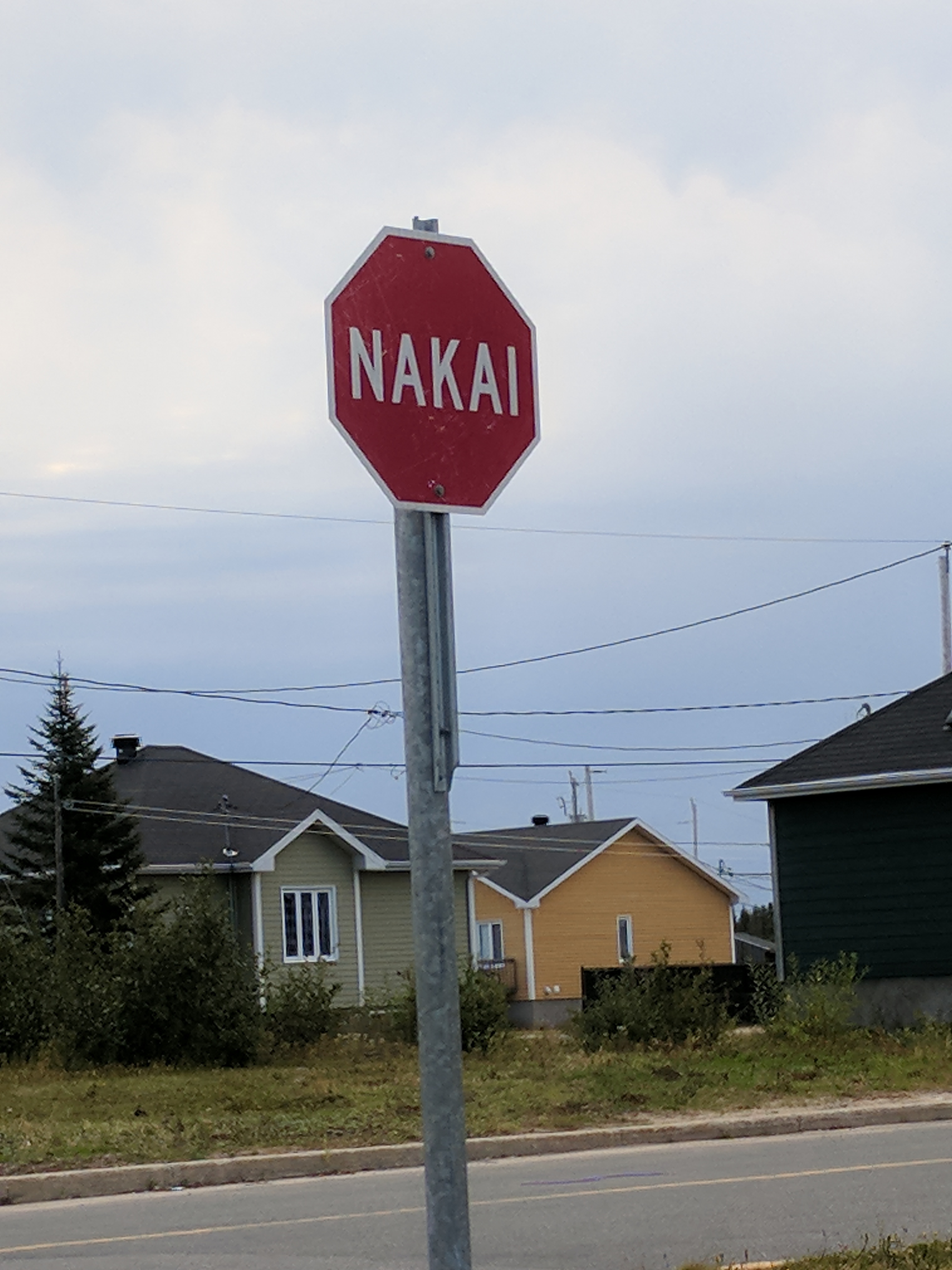|
Matimekosh
Matimekosh (or Matimekush, officially Matimekosh 3) is a First Nations reserve on Lake Pearce in the Côte-Nord region of Quebec, Canada. Together with the Lac-John Reserve, it belongs to the Innu Nation of Matimekush-Lac John. It is an enclave in the centre of the Municipality of Schefferville, and geographically within the Caniapiscau Regional County Municipality but administratively not part of it. ''Matimekosh'' means "small trout". Matimekosh is only accessible by airplane via the Schefferville Airport or by train via Tshiuetin Rail Transportation from Sept-Îles. It is serviced by a nursing station, community radio station, library, arena, community centre, and an aboriginal police force, while water, sewer, and fire protection services are provided by the municipality of Schefferville. History The region was regularly visited by Innu indigenous people for hunting and trapping, but they did not permanently reside there. Because of mining development in the early 1950s, ... [...More Info...] [...Related Items...] OR: [Wikipedia] [Google] [Baidu] |
Schefferville, Quebec
Schefferville is a town in the Canadian province of Quebec. Schefferville is in the heart of the Naskapi and Innu territory in northern Quebec, less than 2 km (1¼ miles) from the border with Labrador on the north shore of Knob Lake. It is located within the Caniapiscau Regional County Municipality and has an area of . Schefferville completely surrounds the autonomous Innu community of Matimekosh, and it abuts the small community of Lac-John Reserve. Both of the latter communities are First Nations Innu reserves. Schefferville is also close to the Naskapi reserved land of Kawawachikamach. The isolated town is not connected to the provincial road network but is accessible by airplane via the Schefferville Airport or by train. Schefferville is the northern terminus of Tshiuetin Rail Transportation (formerly operated by the Quebec North Shore and Labrador Railway) with service to Sept-Îles. McGill University operates the McGill Subarctic Research Station in Scheffervi ... [...More Info...] [...Related Items...] OR: [Wikipedia] [Google] [Baidu] |
Innu Nation Of Matimekush-Lac John
Innu Nation of Matimekush-Lac John (or La Nation Innu Matimekush-Lac John in French) is a First Nation band government based out of Schefferville, Quebec, Canada. The members of the band are Innu people and speak the Innu language, an Algonquian language which is a member of the Cree–Montagnais– Naskapi dialect continuum. Location Schefferville is in northern Quebec less than from the border with Labrador. It is located within the Caniapiscau Regional County Municipality in the '' Côte-Nord'' (or North Coast) region of Quebec. The Nation controls two Indian reserves: Matimekosh 3 is a enclave in the center of the Town of Schefferville; and Lac-John is located about north of Schefferville. Schefferville, and hence the reserves, is not connected to the North American highway system. The community is accessible via air through Schefferville Airport or via rail on Tshiuetin Rail Transportation which is partially owned by the band. Population , the Nation had a re ... [...More Info...] [...Related Items...] OR: [Wikipedia] [Google] [Baidu] |
Kawawachikamach, Quebec
Kawawachikamach ( nsk, script=Cans, ᑲᐛᐛᒋᑲᒪᒡ, translit=Kawâwâchikamach) is a Naskapi/Iyiyiw First Nations reserve and community at the south end of Lake Matemace (where it joins Lake Peter), approximately northeast of Schefferville, Quebec, Canada. It belongs to the Naskapi Nation of Kawawachikamach. The village was built by the Naskapi/Iyiyiw from 1980 to 1983. The language spoken is Iyiyiw-Imuun, a dialect closely related to Innu and Iynu (East Cree). The name means "the winding river". Access to the village is by way of Schefferville Airport or railway from Sept-Îles to Schefferville, then by way of a road from the centre of Schefferville. With the demise of Schefferville as a residential centre for the iron ore mining operations, Kawawachikamach and Matimékush are now the main communities in the region. Telephone and postal services are provided from the Schefferville exchange by Telebec and from the Schefferville Post Office, while electricity is provi ... [...More Info...] [...Related Items...] OR: [Wikipedia] [Google] [Baidu] |
Naskapi
The Naskapi (Nascapi, Naskapee, Nascapee) are an Indigenous people of the Subarctic native to the historical country St'aschinuw (ᒋᑦ ᐊᔅᒋᓄᐤ, meaning 'our nclusiveland'), which is located in northern Quebec and Labrador, neighbouring Nunavik. They are closely related to Innu Nation, who call their homeland ''Nitassinan''. Innu people are frequently divided into two groups, the Neenoilno (called ''Montagnais'' by French people) who live along the north shore of the Gulf of Saint Lawrence, in Quebec, and the less numerous Naskapi who live farther north. The Innu themselves recognize several distinctions (e.g. Mushuau Innuat, Maskuanu Innut, Uashau Innuat) based on different regional affiliations and various dialects of the Innu language. The word "Naskapi" (meaning "people beyond the horizon") first made an appearance in the 17th century and was subsequently applied to Innu groups beyond the reach of missionary influence, most notably those living in the lands w ... [...More Info...] [...Related Items...] OR: [Wikipedia] [Google] [Baidu] |
Caniapiscau Regional County Municipality
Caniapiscau is a regional county municipality in the Côte-Nord region of Quebec, Canada. The seat is Fermont. The census groups Caniapiscau RCM with neighbouring Sept-Rivières into the single census division of Sept-Rivières—Caniapiscau. In the Canada 2011 Census, the combined population was 39,500. The population of Caniapiscau RCM itself was 4260, about two-thirds of whom live in its largest city of Fermont. Subdivisions There are 6 subdivisions and 3 native reserves within the RCM: ;Cities & Towns (2) * Fermont * Schefferville ;Unorganized territories (4) * Caniapiscau * Lac-Juillet * Lac-Vacher * Rivière-Mouchalagane ;Native Reserves (2) * Lac-John * Matimekosh ;Naskapi Reserve (1) * Kawawachikamach Demographics * Land area: 70,389.37 km² * Population: 4,260 Transportation Access routes Highways and numbered routes that run through the municipality, including external routes that start or finish at the county border: * Autoroutes ** None * Princ ... [...More Info...] [...Related Items...] OR: [Wikipedia] [Google] [Baidu] |
Lac-John, Quebec
Lac-John is a First Nations reserve on John Lake in the Côte-Nord region of Quebec, Canada, about north-east from the centre of Schefferville. Together with the Matimekosh Reserve, it belongs to the Innu Nation of Matimekush-Lac John. It is geographically within the Caniapiscau Regional County Municipality but administratively not part of it. The reserve is named after the adjacent John Lake. That name was assigned by the Labrador Mining and Smelting Company, which used it on one of its geological maps a little before 1947. History The region was the northern limit of the hunting and trapping grounds of the Innu indigenous people, but they never had resided there permanently. Because of mining development in the early 1950s, the Naskapi from Fort Chimo and a dozen Innu families from Maliotenam arrived at Schefferville to serve as guides for geological exploration work, and help on the railway construction from Sept-Iles. In 1957, the Schefferville municipal authorities moved t ... [...More Info...] [...Related Items...] OR: [Wikipedia] [Google] [Baidu] |
Innu Communities In Quebec
The Innu / Ilnu ("man", "person") or Innut / Innuat / Ilnuatsh ("people"), formerly called Montagnais from the French colonial period ( French for "mountain people", English pronunciation: ), are the Indigenous inhabitants of territory in the northeastern portion of the present-day province of Labrador and some portions of Quebec. They refer to their traditional homeland as ''Nitassinan'' ("Our Land", ᓂᑕᔅᓯᓇᓐ) or ''Innu-assi'' ("Innu Land"). The Innu are divided into several bands, with the Montagnais being the southernmost group and the Naskapi being the northernmost. Their ancestors were known to have lived on these lands as hunter-gatherers for several thousand years. To support their seasonal hunting migrations, they created portable tents made of animal skins. Their subsistence activities were historically centred on hunting and trapping caribou, moose, deer, and small game. Their language, Ilnu-Aimun or Innu-Aimun (popularly known since the French coloni ... [...More Info...] [...Related Items...] OR: [Wikipedia] [Google] [Baidu] |
Innu
The Innu / Ilnu ("man", "person") or Innut / Innuat / Ilnuatsh ("people"), formerly called Montagnais from the French colonial period (French for "mountain people", English pronunciation: ), are the Indigenous inhabitants of territory in the northeastern portion of the present-day province of Labrador and some portions of Quebec. They refer to their traditional homeland as ''Nitassinan'' ("Our Land", ᓂᑕᔅᓯᓇᓐ) or ''Innu-assi'' ("Innu Land"). The Innu are divided into several bands, with the Montagnais being the southernmost group and the Naskapi being the northernmost. Their ancestors were known to have lived on these lands as hunter-gatherers for several thousand years. To support their seasonal hunting migrations, they created portable tents made of animal skins. Their subsistence activities were historically centred on hunting and trapping caribou, moose, deer, and small game. Their language, Ilnu-Aimun or Innu-Aimun (popularly known since the French colonial ... [...More Info...] [...Related Items...] OR: [Wikipedia] [Google] [Baidu] |
Uashat-Maliotenam
Innu Takuaikan Uashat Mak Mani-Utenam is an Innu First Nations band government in Quebec, Canada. It is based in Sept-Îles in the Côte-Nord region on the North shore of the Saint Lawrence River. It owns two reserves: Maliotenam 27A and Uashat 27 located at both ends of Sept-Îles. It is governed by a band council and is a member of the Mamuitun Tribal Council. Population , the band has a total registered population of 4,781 members. According to Statistics Canada's 2016 Canadian Census, Uashat had a population of 1,592 up 7.2% from 1,485 found in the 2011 Census. Maliotenam had a population of 1,542 in 2016, up 17.2% from 1,316 in 2011. Politics The Nation is governed by a chief and band council of six members. For the 2019–2022 tenure, the chief of the band council of Uasuat-Maliotenam is Mike (Pelash) McKenzie. The Innu of Uashat-Maliotenam and those of Matimekosh-Lac-John are represented in land claims negotiations by the ''Corporation Ashuanipi''. Languages The ... [...More Info...] [...Related Items...] OR: [Wikipedia] [Google] [Baidu] |
Côte-Nord
Côte-Nord (, ; ; land area ) is the second-largest administrative region by land area in Quebec, Canada, after Nord-du-Québec. It covers much of the northern shore of the Saint Lawrence River estuary and the Gulf of Saint Lawrence past Tadoussac. While most of the region is in the same time zone as the rest of Quebec, the far eastern portion east of the 63rd meridian, excluding the Minganie Regional County Municipality, is officially in the Atlantic Time Zone and does not observe daylight saving time. Population At the 2016 Canadian Census, the population amounted to 92,518, approximately 1.1% of the province's population, spread across 33 municipalities, various Indian reserves and a Naskapi reserved land. The towns of Baie-Comeau and Sept-Îles combined amount to a little more than half of the population of the region. Geography and economy Côte-Nord was created as an administrative region in 1966. Important landmarks of Côte-Nord include Anticosti Island, the Ming ... [...More Info...] [...Related Items...] OR: [Wikipedia] [Google] [Baidu] |
Duplessis (electoral District)
Duplessis is a provincial electoral district in the Côte-Nord region of Quebec, Canada, that elects members to the National Assembly of Quebec. It notably includes the municipalities of Sept-Îles, Port-Cartier, Havre-Saint-Pierre, Fermont and the community of Maliotenam. It also includes a single municipality from the Nord-du-Québec region: the Naskapi village municipality of Kawawachikamach (not to be confused with the Naskapi reserved land of the same name, which Duplessis also includes, but is in Côte-Nord). It was created for the 1960 election from parts of the Saguenay provincial electoral district. In the change from the 2001 to the 2011 electoral map, it gained the unorganized territories of Caniapiscau and Lac-Juillet from Ungava electoral district. The riding was named after former Quebec Premier Maurice Duplessis who led the province from 1936 to 1939 and from 1944 to 1959 as leader of the Union Nationale. Members of the Legislative Assembly / Nationa ... [...More Info...] [...Related Items...] OR: [Wikipedia] [Google] [Baidu] |



_LABRADOR-EXP._p364_A_VISIT_TO_OTELNE_IN_HIS_LODGE.jpg)
